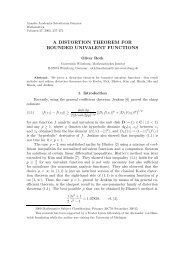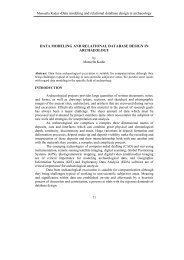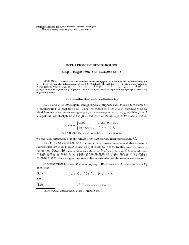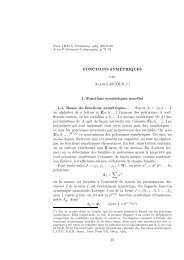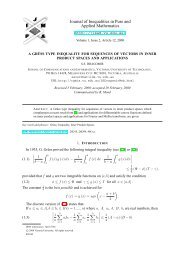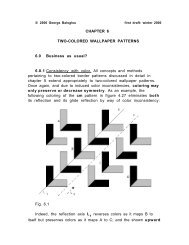SUPERNOMIAL COEFFICIENTS, BAILEY'S LEMMA AND ROGERS ...
SUPERNOMIAL COEFFICIENTS, BAILEY'S LEMMA AND ROGERS ...
SUPERNOMIAL COEFFICIENTS, BAILEY'S LEMMA AND ROGERS ...
Create successful ePaper yourself
Turn your PDF publications into a flip-book with our unique Google optimized e-Paper software.
<strong>SUPERNOMIAL</strong> <strong>COEFFICIENTS</strong> . . . 7Theorem 3.2. Let L, M ∈ Z 2 +, k ∈ Z 3 , such that |k| = 0 and let S(L, k) bethe A 2 supernomial defined in (3.7) and T (L, k) be defined in (3.11) below.Then(3.9)and(3.10)M∑L=0q 1 2 LCL S(L, k)(q) M−L= q 1 2 (k2 1 +k2 2 +k2 3 ) (q) |M| T (M, k)M∑L=0q 1 2 LCL T (L, k)(q) M−L= q 1 2 (k2 1 +k2 2 +k2 3 ) T (M, k).So we do find an invariance property, but only after summing the supernomialS to a new q-function T , given in the following definition.Definition 3.3. For L ∈ Z 2 + and k ∈ Z 3 such that |k| = 0,(3.11)T (L, k) =1(q) 2 L 1 +L 23∏i=1[ ]L1 + L 2.L 1 + k iThe fact that (3.8) is not correct and has to be replaced by the non-trivialtheorem 3.2 is the main obstacle for treating the general rank case. Indeed,for arbitrary A n−1 we find that (L, M ∈ Z n−1+ , k ∈ Z n such that |k| = 0)M∑L=0q 1 2 LCL S(L, k)(q) M−L= q 1 2 (k2 1 +···+k2 n ) S(M, k)is invalid for any n ≥ 3. How to correct this, in a way similar to Theorem 3.2,is unclear to us at present. A partial result on A n−1 is given in proposition 6.1of section 6.4. A 2 Rogers–Ramanujan-type identitiesWe now use the two summations of theorem 3.2 to obtain A 2 analogues oftheorems 2.1 and 2.2. Were there 2 cases to consider for A 1 , corresponding toodd and even modulus, this time we have to consider moduli in the residueclasses of 3.First we need the A 2 generalization of (3.3) (proposition 5.1 of [9] withl = 0).Proposition 4.1. For L ∈ Z 2 such that CL ∈ Z 2 +,∑ ∑ɛ(σ)q 1 ∑ 32 i=1 (3k i−2σ i )k(4.1)iS(L, 3k − σ + ρ) = δ L1 ,0δ L2 ,0.σ∈S 3|k|=0



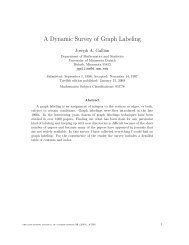


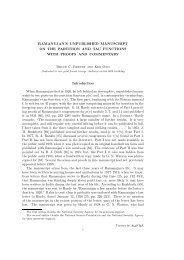
![(.,t ] and [s, .) , where [s,t ] = {s' GT; s ¤ s' ¤ t} , (.,t ] = {s' GT; s' ¤ t} and ...](https://img.yumpu.com/43303393/1/184x260/t-and-s-where-st-s-gt-s-a-s-a-t-t-s-gt-s-a-t-and-.jpg?quality=85)


